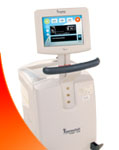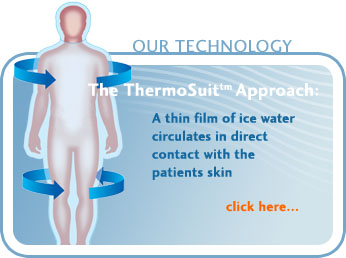How fast do you cool?
The LRS ThermoSuit System uses the principal of cold water immersion to cool rapidly. The median cooling time reported in a multi-center clinical evaluation of the ThermoSuit System [1] was 37 minutes. In a subset of patients who were sedated with Propofol the median cooling rate was 27 minutes. This cooling rate is consistent with previously published data from human cooling studies [2].
Can you cool too fast?
No. Extremely rapid cooling has long been provided during surgical cardiopulmonary bypass procedures, and this has not been reported to be associated with patient injury. The typical cooling rate during a cardiopulmonary bypass procedure is on the order of 40º C/hr [3]. This cooling rate is more than five times as rapid as that provided by the ThermoSuit® System.
How do you measure patient temperature?
High speed cooling requires a fast responding temperature probe. We use an esophageal temperature and it is included in the ThermoSuit Disposables Kit. Our animal research has determined that esophageal temperature correlates well with Pulmonary Artery temperature which in turn is reflective of Brain temperature. Bladder probes and rectal temperature probes are too slow to be used for control when doing temperature induction with the ThermoSuit cooling system. Esophageal temperature probes are well suited for use during the maintenance and rewarming periods as well.
How do I get patient access if the patient is in the ThermoSuit®?
The patient is fully accessible during the cooling process. The Top cooling sheet is attached to the lower portion of the ThermoSuit by Velcro strips. This allows the clinician to route IV lines, ECG and defibrillation lines out of the suit as needed. If patient access is required during cooling, just hit the pause button on the pump to pause the top sheet flow and peel back the top sheet to access your patient. You will continue cooling from the bottom of the patient during this time period. If desired, press the pause button twice and all cooling fluid flow is stopped. From either mode, hit the green arrow and cooling fluid flow restarts. Thus you can have patient access at any time and cool simultaneously!
What about access sites and the need for femoral lines?
Since your patient will be in the ThermoSuit for approximately 30 minutes during the cooling cycle and will get wet during ThermoSuit cooling, our operation manual recommends that you cover catheterization sites and electrodes with occlusive dressing such as Opsite. These are designed to protect surgical incision and Catheterization sites in the presence of water, such as when bathing the patient.
How do I defibrillate a patient in water? Can I give CPR?
With the ThermoSuit, you have two options for administering defibrillation during the cooling process. One is to pause the flow to the suit, open the top sheet, dry the front of the patient, and defibrillate using a hands-free approach with self-adhesive electrodes. In essence, this would be akin to defibrillating someone who is lying on a wet surface, which has been shown to be safe by the defibrillator manufacturers.
The second approach to consider is to defibrillate while the ThermoSuit is running, WITHOUT interrupting top sheet flow. This would mean that water would be running over the electrodes during countershock.
To study this approach, LRS sponsored animal studies at the University of Rhode Island and University of Vienna to look at the conditions of wet defibrillation in the ThermoSuit.
In the experiments, pigs were subjected to induced VF and defibrillated while in the Thermosuit. Both dry and wet conditions were studied, as well as normothermic and hypothermic temperatures of the animals. The test conditions were randomized. The results demonstrated that this approach was successful, assuming the adhesive electrodes were applied to dry skin before activating the coolant flow into the suit [4]. The ability to successfully administer defibrillation in wet conditions has also been demonstrated in the setting of ocean-going rescue craft [5].
In summary, the approach to defibrillation during ThermoSuit treatment (i.e., to pause or not to pause) is up to the clinician. Either approach will work.
CPR can readily be given with the patient in the ThermoSuit with the flow paused (hit pause twice). It is suggested that a backboard be placed under the patient before cooling is started to facilitate administration of CPR if needed during cooling.
Is fast cooling really important?
There is a growing body of evidence that fast cooling is important. This topic is discussed in a number of published reports [6, 7, 8, 9, 10, 11, 12], as well as elsewhere.
You cool, what about maintenance and rewarming?
Once patients who are cooled to target temperature with the ThermoSuit System and are removed from the ThermoSuit, they tend to stay cold for many hours with little or no further maintenance required [1]. ThermoSuit users have reported that many of their patients stay at target temperature for the full 12 – 24 hour period. If the patients start to warm up on their own, simple maintenance such as blowing cool air on the patient will keep them in the 32 – 34o C range. Some customers use a simple cooling blanket under the patient to maintain temperature if required. According to the AHA guidelines, patients are to be maintained in the range of 32 – 34o C for 12 – 24 hours before being rewarmed.
This wide range of temperature can easily be maintained on any ThermoSuit patient as the requirement is 33 +/- 1o C. No clinical benefit has been demonstrated WITH tighter temperature control than required by AHA guidelines. Rewarming of ThermoSuit cooled patients is simple as well.



